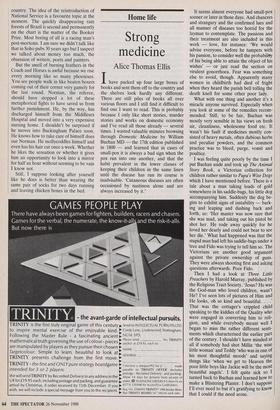Home life
Strong medicine
Alice Thomas Ellis
Ihave packed up four large boxes of books and sent them off to the country and the shelves look hardly any different. There are still piles of books all over various floors and I still find it difficult to find one I want to read. This is probably because I only like short stories, murder stories and works on domestic economy and I've read all those already — several times. I wasted valuable minutes browsing through Domestic Medicine by William Buchan MD — the 17th edition published in 1800 — and learned that in cases of small-pox it is always a bad sign when the pox run into one another, and that the habit prevalent in the lower classes of keeping their children in the same linen until the disease has run its course is inadvisable. `Cutaneous diseases are often occasioned by nastiness alone and are always increased by it.' It seems almost everyone had small-pox sooner or later in those days. And chancres and strangury and the confirmed lues and all manner of diseases too horrid for the layman to contemplate. The passions and their treatment are also included in this work — love, for instance: 'We would advise everyone, before he tampers with his passion, to consider well the probability of his being able to attain the object of his wishes' — or just read the section on virulent gonorrhoea. Fear was something else to avoid, though. Apparently many women in childbirth had died of fright when they heard the parish bell tolling the death knell for some other poor lady.
What with one thing and another it's a miracle anyone survived. Especially when you look at some of the remedies recom- mended. Still, to be fair, Buchan was mostly very sensible in his views on fresh air, cleanliness, wholesome food etc. It wasn't his fault if medicines mostly con- sisted of heavy metals, often dubious herbs and peculiar powders, and the common practice was to bleed, purge, vomit and poultice. I was feeling quite poorly by the time I put Buchan aside and took up The Animal Story Book, a Victorian collection for children rather similar to Papa's Wise Dogs which I have mentioned before. There is a tale about a man taking loads of gold somewhere in his saddle-bags, his little dog accompanying him. Suddenly the dog be- gins to exhibit signs of instability — bark- ing and leaping and dashing back and forth, so: `Her master was now sure that she was mad, and taking out his pistol he shot her. He rode away quickly for he loved her dearly and could not bear to see her die.' What had happened was that the stupid man had left his saddle-bags under a tree and Fido was trying to tell him so. The Victorians are another good argument against the private ownership of guns. They were always shooting first and asking questions afterwards. Poor Fido.
Then I had a look at Three Little Preachers by Harold Murray, published by the Religious Tract Society. 'Jesus? He was the God-man who loved children, wasn't He? I've seen lots of pictures of Him and He looks, oh so kind and beautiful. . . That was the cottager's crippled child speaking to the kiddies of the Quality who were engaged in converting him to reli- gion, and while everybody meant well I began to miss the rather different senti- ments which characterised the earlier part of the century. I shouldn't have minded at all if somebody had shot Millie 'the wise little woman' and Teddy 'who was in one of his most thoughtful moods' and saying things like 'when we get to Heaven the poor little boys like Jackie will be the most beautiful angels'. I felt quite sick so I turned back to Buchan and learned how to make a Blistering Plaster. I don't suppose I'll ever need to but it's gratifying to know that I could if the need arose.










































































 Previous page
Previous page